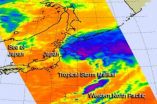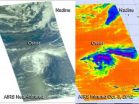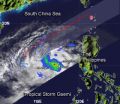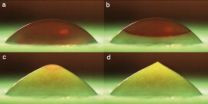(Press-News.org) At first blush, many people would probably love to get rid of insects, such as pesky mosquitoes, ants and roaches. But a new study indicates that getting rid of insects could trigger some unwelcome ecological consequences, such as the rapid loss of desired traits in plants, including their good taste and high yields.
Specifically, the study--described in the Oct. 5, 2012 issue of Science and funded by the National Science Foundation showed that evening primroses grown in insecticide-treated plots quickly lost, through evolution, defensive traits that helped protect them from plant-eating moths. The protective traits lost included the production of insect-deterring chemicals and later blooms that gave evening primroses temporal distance from plant-eating larvae that peak early in the growing season.
These results indicate that once the plants no longer needed their anti-insect defenses, they lost those defenses. What's more, they did so quickly--in only three or four generations.
Anurag Agrawal, the leader of the study and a professor of ecology and evolutionary biology at Cornell University, explains, "We demonstrated that when you take moths out of the environment, certain varieties of evening primrose were particularly successful. These successful varieties have genes that produce less defenses against moths."
In the absence of insects, the evening primroses apparently stopped investing energy in their anti-insect defenses, and so these defenses disappeared through natural selection. Agrawal says that he was "very surprised" by how quickly this process occurred, and that such surprises, "tell us something about the potential speed and complexities of evolution. In addition, experiments like ours that follow evolutionary change in real-time provide definitive evidence of evolution."
Agrawal believes that his team's study results are applicable to many other insect-plant interactions beyond evening primroses and moths. Here's why: The ubiquitous consumption of plants by insects represents one of the dominant species interactions on Earth. With insect-plant relationships so important, it is widely believed that many plant traits originally evolved solely as defenses against insects. Some of these anti-insect plant defenses, such as the bitter taste of some fruits, are desirable.
"This experimental demonstration of how rapid evolution can shape ecological interactions supports the idea that we need to understand feedbacks between evolutionary and ecological processes in order to be able to predict how communities and ecosystems will respond to change," said Alan Tessier, a program director in NSF's Directorate for Biological Sciences.
"One of the things farmers are trying to do is breed agricultural crops to be more resistant to pests," said Agrawal. "Our study indicates that various genetic tradeoffs may make it difficult or impossible to maintain certain desired traits in plants that are bred for pest resistance."
In addition, oils produced by evening primroses have been used medicinally for hundreds of years and are beginning to be used as herbal remedies. Agrawal's insights about pests that attack these plants and about chemical compounds produced by these plants may ultimately be useful to the herbal and pharmaceutical industries.
Agrawal says that most previous real-time experiments on evolution have been conducted with bacteria in test tubes in laboratories. "One of things we were excited about is that we were able to repeat that kind of experiment in nature. You can expect to see a lot more of this kind of thing in future. We will keep our experiment running as a long-term living laboratory. "
INFORMATION:
More information about this study is available from a Cornell University press release.
Why we need insects -- even 'pesky' ones
Hard evidence of evolution: A 5-year study shows that plants may quickly lose important traits through evolution soon after insects are removed from the environment
2012-10-05
ELSE PRESS RELEASES FROM THIS DATE:
MU researcher identifies factors to help parents and professionals recognize teens in distress
2012-10-05
Suicide is the third-leading cause of death for teens, according to the Centers for Disease Control and Prevention. Now, a University of Missouri public health expert has identified factors that will help parents, medical professionals and educators recognize teens at risk for self injury and suicide.
"For many young people, suicide represents an escape from unbearable situations—problems that seem impossible to solve or negative emotions that feel overwhelming," said Lindsay Taliaferro, an assistant professor of health sciences at MU. "Adults can help these teens dissect ...
Sandia Labs benchmark helps wind industry measure success
2012-10-05
ALBUQUERQUE, N.M. – Sandia National Laboratories published the second annual 2012 Wind Plant Reliability Benchmark on Monday, and the results should help the nation's growing wind industry benchmark its performance, understand vulnerabilities and enhance productivity.
Until now, wind farm owners and operators had no way to compare their output with the output of similar operations. To benchmark the reliability of the U.S. wind turbine fleet and identify major causes of failures and downtime, the DOE commissioned Sandia in 2010 to build the Continuous Reliability Enhancement ...
Far, far beyond wrist radios
2012-10-05
To believe that technologies once dreamed of in science fiction novels, television shows, and comic strips may one day be a reality, or that real-world technologies might make the fantastic devices of fiction obsolete, you'd need to be either an optimist…or a futurist in the Department of Homeland Security (DHS)'s Science and Technology Directorate (S&T).
To keep dreams grounded, S&T maintains a team of futurists in Arlington, Va., at the Homeland Security Studies & Analysis Institute (HSSAI). There, in the Resilience and Emergency Preparedness / Response Branch, analysts ...
NASA sees Tropical Storm Maliksi put final touches on Japan
2012-10-05
Tropical Storm Maliksi is putting the final touches on Japan, that is, the edge of the storm was seen brushing the country's northern coast as it pulled away on NASA satellite imagery.
NASA's Aqua satellite passed over Tropical Storm Maliksi on Oct. 4 at 0329 UTC (11:29 p.m. EDT, Oct. 3, EDT) and the Atmospheric Infrared Sounder (AIRS) instrument captured an infrared image of the storm brushing the Tohoku and Hokkaido prefectures of northern Japan.
On Oct. 4, 2012 at 1500 UTC (11 a.m. EDT), the Joint Typhoon Warning Center issued their final advisory on Maliksi. At ...
NASA gets 2 infrared views of tropical storms Nadine, Oscar
2012-10-05
NASA's Aqua satellite provided two different infrared views of the two tropical storms swirling in the Atlantic Ocean. Oscar is battling wind shear that appears destined to tear it apart, while Nadine is merging with a cold front.
NASA's Aqua satellite passed over both Tropical Storm Nadine and Tropical Depression 15 (TD15) on Oct. 3 at 1553 UTC (11:53 a.m. EDT), before TD15 became Tropical Storm Oscar. While overhead, the Atmospheric Infrared Sounder (AIRS) instrument aboard Aqua captured two different images of both storms. One image was near infrared and almost visible ...
NASA sees Tropical Storm Gaemi's heaviest rainfall around center
2012-10-05
Some of the most powerful thunderstorms in a tropical cyclone surround the center of circulation, and NASA's TRMM satellite noticed that rainfall is heaviest in that area of Tropical Storm Gaemi.
When NASA's Tropical Rainfall Measuring Mission (TRMM) satellite passed over Tropical Storm Gaemi on Oct. 3 at 1241 UTC (8:41 a.m. EDT), the precipitation radar instrument detected light rainfall occurring over most of the storm. Moderate rain was falling at a rate between .78 to 1.57 inches/20 to 40 mm per hour and surrounded a small area of heavy rainfall circling tightly around ...
Freezing water droplets form sharp ice peaks
2012-10-05
Researchers at the University of Twente, in the Netherlands, placed water droplets on a plate chilled to -20 degrees Celsius and captured images as a freezing front traveled up the droplet. The photos are published in the American Institute of Physics' (AIP) journal Physics of Fluids. The approximately 4-millimeter diameter droplets took about 20 seconds to freeze. During the final stage of freezing, the ice drop developed a pointy tip, as can be seen in Figure 1d. The effect, which is not observed for most other liquids, arises because water expands as it freezes. The ...
IntuiTouch Technologies Announces Development of ChiroSpring Practice Management Software
2012-10-05
"ChiroSpring is unique in the chiropractic software industry because it combines the most advanced technology with a design that couldn't be easier to use," said Brian Albery, CEO of ChiroSpring. "Doctors want electronic chiropractic software that allows their practice to run at maximum efficiency, but is also easy and intuitive to operate. While other chiropractor software programs force you to choose between functionality and simplicity, ChiroSpring offers an unbeatable combination of both. The best chiropractic software should give doctors everything they ...
Dr. Aristotle Economou, Acclaimed Functional Medicine Practitioner and Author of Change The Way You Heal, to Provide Free Telecall on Accelerated Pain Relief
2012-10-05
Dr. Aristotle Economou will provide a no cost telecall for people who wish to speed up the healing process and spend their time engaging in activities they enjoy. Using over 20 years of experience in the field of Functional Medicine, Dr. Aristotle Economou will discuss techniques on how to actively support the healing process.
Intended for an audience of health- and healing-conscious men and women, Pain Relief at the Speed of Light will provide techniques on how to relieve pain, as well as how to avoid it. The free telecall will highlight recuperation methods in the ...
Zac Pac Australia
2012-10-05
Zacpac, an independently owned and family run Australian Packaging business again proves that they're not only the pioneers in Australian packaging solutionsbut also are the best in providing fast, quality services and their continued growth has resulted in an all-new factory being built to satisfy demand. The new 8000 square metrestructure takes the total factory operating space to 19,000 square metres.
After purchasing ten acres of land in Ingleburn in 1991 and building the company's first factory in 1994, Ed Zac's vision of expanding the family business, specialising ...
LAST 30 PRESS RELEASES:
Making lighter work of calculating fluid and heat flow
Normalizing blood sugar can halve heart attack risk
Lowering blood sugar cuts heart attack risk in people with prediabetes
Study links genetic variants to risk of blinding eye disease in premature infants
Non-opioid ‘pain sponge’ therapy halts cartilage degeneration and relieves chronic pain
AI can pick up cultural values by mimicking how kids learn
China’s ecological redlines offer fast track to 30 x 30 global conservation goal
Invisible indoor threats: emerging household contaminants and their growing risks to human health
Adding antibody treatment to chemo boosts outcomes for children with rare cancer
Germline pathogenic variants among women without a history of breast cancer
Tanning beds triple melanoma risk, potentially causing broad DNA damage
Unique bond identified as key to viral infection speed
Indoor tanning makes youthful skin much older on a genetic level
Mouse model sheds new light on the causes and potential solutions to human GI problems linked to muscular dystrophy
The Journal of Nuclear Medicine ahead-of-print tip sheet: December 12, 2025
Smarter tools for peering into the microscopic world
Applications open for funding to conduct research in the Kinsey Institute archives
Global measure underestimates the severity of food insecurity
Child survivors of critical illness are missing out on timely follow up care
Risk-based vs annual breast cancer screening / the WISDOM randomized clinical trial
University of Toronto launches Electric Vehicle Innovation Ontario to accelerate advanced EV technologies and build Canada’s innovation advantage
Early relapse predicts poor outcomes in aggressive blood cancer
American College of Lifestyle Medicine applauds two CMS models aligned with lifestyle medicine practice and reimbursement
Clinical trial finds cannabis use not a barrier to quitting nicotine vaping
Supplemental nutrition assistance program policies and food insecurity
Switching immune cells to “night mode” could limit damage after a heart attack, study suggests
URI-based Global RIghts Project report spotlights continued troubling trends in worldwide inhumane treatment
Neutrophils are less aggressive at night, explaining why nighttime heart attacks cause less damage than daytime events
Menopausal hormone therapy may not pose breast cancer risk for women with BRCA mutations
Mobile health tool may improve quality of life for adolescent and young adult breast cancer survivors
[Press-News.org] Why we need insects -- even 'pesky' onesHard evidence of evolution: A 5-year study shows that plants may quickly lose important traits through evolution soon after insects are removed from the environment






